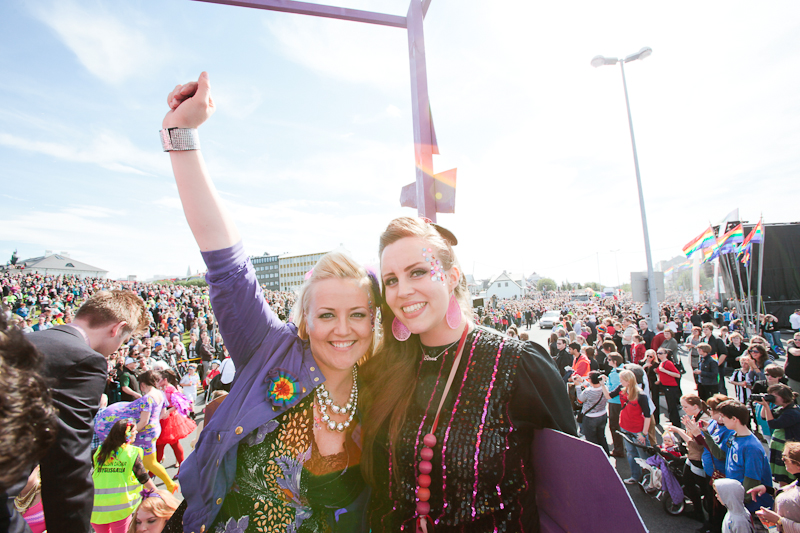Almost a third of the nation shows up to watch the Pride Parade every year. Despite the obvious support, there is still prejudice against queer people in Iceland, and there is still need to campaign for queer rights, says Eva María Þórarinsdóttir Lange, the chairman of Reykjavík Pride. This year‘s theme is queer health.
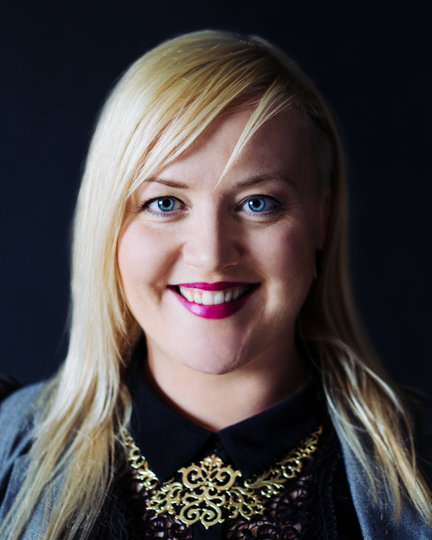
Reykjavík Pride will take place between August 4th to August 9th this year. Planning is well on its way and today, Thursday, the Festival Guide, a magazine including all of the Pride‘s events as well as interesting stories from the fight for queer rights, will be introduced during a big party in it‘s honor.
„The Festival Guide is really the bible of Reykjavík Pride,“ says Eva María. „It‘s packed with our history and we use the guide to introduce our program and also to shed some light on the issues being dealt with in the educational events during Pride.“
Eva María is no stranger to the planning of Reykjavik Pride as this is her third year as chairman. „My girlfriend, Birna, was involved in education for Samtökin ’78 (e. The National Queer Organization) and in queer matters in general. Some of it rubbed off and once I begun I couldn‘t stop,“ she says, asked about how she first became involved in Reykjavík Pride half a decade ago.
„In the end, we felt that the parade might not be the best place for BDSM to step out in public, in light of the aforementioned reaction, accusations and resistance from the queer community.“
„The Pride has changed in that time, in accordance with changes in the society. Twenty years ago we were fighting to keep our jobs if we came out of the closet, but today we have come further.“
A healthy focus
The theme for this year‘s Pride is health, in a broad sense. „We‘ll talk about physical health, mental health and everything connected with health. We will look at the health care system and how groups like intersex people and trans people are treated within the health sector. There is a bit of criticism on the lack of knowledge in the health care system,“ Eva María tells us.
„We‘ll try to examine specialized healthcare and related services, tailored to the needs of these minorities, but also visit familiar subjects like HIV, the mental issues associated with coming out, what people feel like when coming out in schools and so on. We‘ll also talk about sexual violence and how it‘s dealt with and whether sufferers get any help and so on. We‘re discussing the topic from many different angles, but the focus is on issues that relate directly to queer people.“
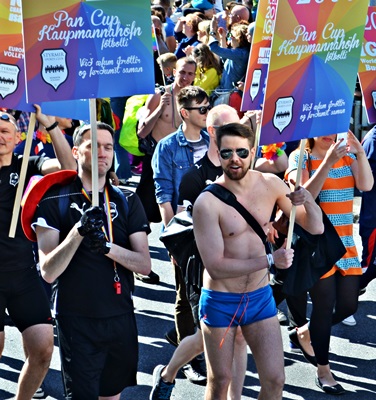
Photo shows members of sports club Styrmir.
Reykjavík Pride is a six-day celebration, packed with events, including a series of lectures and other educational events everyone can take part in. „In the beginning the emphasis will be on events of a quieter nature, a lot of educational events, sport events, blood donations and field games. As it gets closer to the weekend though, the tempo increases, and so does the partying. Reykjavík Pride is different from other prides in the sense that education plays a big role, and that‘s quite unique,“ Eva María explains.
Asked for recommendations for some of the events that are included every year, she is in no shortage of answers. „The opening ceremony has been one of the main events since Pride became an organized festival. It takes part on Thursday and it‘s almost like a family reunion for queer people. It‘s the evening when everyone comes together, from twenty to eighty years old, and every year they play Somewhere Over the Rainbow and I Am What I Am. I know it may sound like a cliché, but it‘s a beautiful moment. Everyone has something in common and they meet to celebrate being the way they are.“
She also mentions the final dance, after the parade on Saturday, and the family entertainment on Sunday. „This year we‘ve teamed up with Circus Iceland for a family event during the day and then an over 18 event in the evening.“ Another thing is the cruise on Friday night. „It‘s a little funny because Iceland isn‘t really known for warm weather but in many other countries there is a big culture of gay cruises. There it‘s mostly well-shaped men in Speedos, but here it‘s more like red noses and rain coats going on an hour-long boat trip. But it‘s really good fun and the company is excellent!“
The loud minority
Despite the majority of Icelanders being supportive of queer rights, each year during the days following Reykjavík Pride, a loud minority publicly condemns the Pride, and in particular the parade. The organizers have even been accused by this minority of harming children by exposing them do indecency and unnatural lifestyle. These critics also claim that all gays are child molesters.
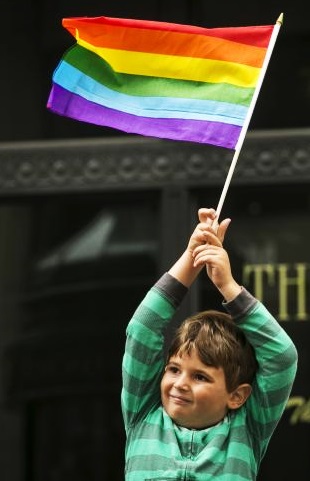
the wake of all this he asked: ‚Does that
mean my uncle is a child molester?‘
Eva María shakes her head. „When one critic starts, others follow as part of the pack. My loved ones have asked me if I take these kind of comments personally, if they hurt me. They don’t. Not personally. What hurts me is that they reach those who are vulnerable. We, the people in the frontline have learned this is just a part of the job, and we see a lot of it. Only a small part finds its way to the media. But there are those who are not ready to hear those things. For example, young kids struggling with coming out. When they hear this it becomes so easy to back out.“
Eva María points out that prejudice can appear in many ways. „I sometimes talk about „civilized“ prejudice. When people say ‚I‘ve got nothing against gays, but do they really have to be showing themselves off like this?‘. And then you have other kinds of prejudice, disgusting prejudice. Like when the Russian orthodox church bought an ad in a newspaper on Pride Saturday, basically saying that some people will burn in hell, including those who sleep with someone of the same-sex.“
However opening up the discussion with claims like these is not all bad, according to Eva María. „Sometimes you just have to see the good in things. The man who’s made most of the damning accusations of Pride has never seen the Pride parade, which is quite peculiar. One example; he talked a lot about men bearing their bottoms, but the only two men bearing their buttocks in the last years have been straight men, pushed in to the Parade, during stag parties. So, really, they were there to make fun of us and belittling our struggle. So the accusations came from the wrong direction. Personally I don’t mind seeing a buttock or two but I’d rather it be an expression of some aspect of queer life than a demeaning gesture from a straight stag.
The same man, the one who made those accusations, then tried to sue me personally, but had no luck because he didn‘t have a case. It‘s been an eye-opening experience. You think it‘s so good to live in Iceland because everyone is easy-going and accepting, and then all of a sudden it backlashes and that really makes you see how far we still have to go. The victory isn’t won. We can never stop being on guard for our rights.“
Criticism from the queer community
Surprisingly, Reykjavík Pride hasn‘t only been criticized by homophobes. Within the queer community, some find the parade to be too inclusive, letting scouts and intersex people join the march. Others find the parade to be too exclusive, as the national BDSM club was denied permission to take part. Still others claim that those taking part in the parade can not seek grants or funding for their acts, as all grants and donation must go to the Pride itself.
„That‘s not true. Anyone can financially support an act or a float in the parade,“ Eva María answers. „But the supporters or funders can not be visible. There is no advertising in the parade. Other pride organizers salute us for it. Our opinion is that as long as we can keep advertising out of the parade, then the focus is on the right place.
In return, we offer small grants for materials for those who want. We also help provide a sound system. If anyone wants to seek further sponsorship that is just fine, but no sponsorship advertising is allowed.
In other countries, companies literally pay to be in the parade, and that‘s how the parade is funded. There‘s a fundamental difference in the type of parade you get then, instead of just having the grassroot.“
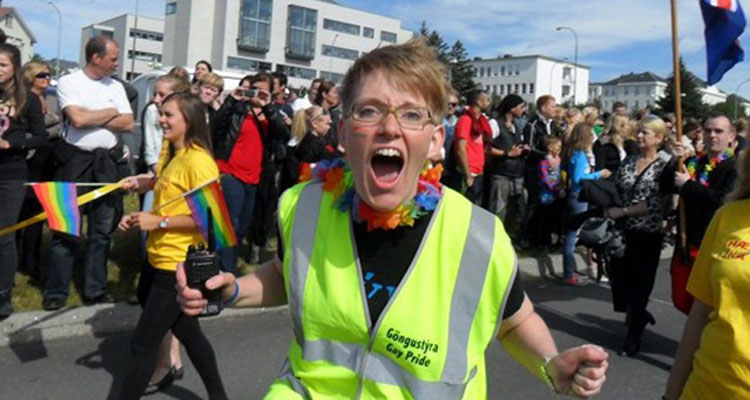
As for who‘s allowed to march in the parade and not, Eva María says it depends on what you‘re marching for and how you do it.
„Take the scouts, for example. Five years ago I wouldn‘t have dreamt about having scouts in the parade. You hear these extreme cases from the US, about the Scout movement being homophobic. So I thought it was really cool when Icelandic scouts wanted to send out a message against the treatment of queer scouts in the US by saying they are supporters and not homophobic. For sending out such a strong message, they are included in Pride. The message you want to send with participating must be clear.“
Last year, the national BDSM club applied to join the parade but wasn‘t granted permission. „There are five of us on the board of Reykjavík Pride and it was a split decision. In the end, we felt that the parade might not be the best place for BDSM to step out in public, in light of the aforementioned reaction, accusations and resistance from the queer community. Instead we offered them to host an educational event, which they will do during this year‘s Pride.
My personal opinion is that the parade is really vulnerable to prejudice and opinion and it’s constantly evolving. The main goal is to show up proud celebrating our culture and making our demands for human rights visible. So we try to come to thought-out decisions when granting access to the Parade. For example, Icelanders are a little behind when it comes to sensitivity about race. „Blackface“ wasn‘t considered a big deal in Iceland a few years ago when we banned it from the parade. At one time the Trans community was excluded and until last year we had no Intersex presence. Things are changing and evolving and the definition of ‘queer’ is ever-expanding.
„Icelanders are a little behind when it comes to sensitivity about race. „Blackface“ wasn‘t considered a big deal in Iceland a few years ago when we banned it from the parade.“
Including intersex people in the parade is clearly something Eva María makes no apologies for. „Reykjavík Pride was the first pride in the world to welcome intersex people and as a result the intersex people in Iceland have been leading in educating other prides. The next pride to include the group will be in Copenhagen and the lead person for that is our Kitty Anderson, president of Intersex-Iceland.
The campaigning for human rights is changing, as society changes. A few years ago Samtökin ’78 was called „The Icelandic organization for gays and lesbians“, today it also includes bisexual, asexual, pansexual, transgender and intersex people.“
Cries when she sees the grandmothers
Reykjavík‘s Pride Festival Guide will be available from today, July 16th, but those wanting to take part in the parade can still apply. „Registration is open until the 1st of August. It‘s vital that people register so that we can make sure everyone has a slot, and give us time to help out in case they need a sound system and so on. There are already many wonderful acts listed, but those who want to join can apply on the Pride‘s website.
Due to the enormous public involvement in Reykjavík Pride, it‘s sometimes dubbed as a family entertainment. Eva María emphasizes that the idea behind it is quite different. „Pride parades are a part of the fight for equal rights, both historically and today. What happened in Iceland is that we live in such a small society that if you know someone who is queer, you love someone who is queer. Automatically you become a supporter and a spokesperson for our free existence and inclusion. I think this is what defines Iceland and this is why we see grandmothers holding their grandchildren in their arms, while waving the rainbow flag. And that‘s something that gets my crying every single time. Without fail.“
Despite spending countless hours organizing Reykjavík Pride, along with as many as 100 other volunteers, Eva María at the young age of 34, still has time to run a successful business. She says her days as a DJ have come to and end though, due to lack of time.
„I‘m a bit hyperactive. I often ask myself why I‘m doing this, but during the Pride‘s high peak, I know why. It‘s also fun to be an active participant in the community, being part of history and doing some good. It‘s very rewarding!“
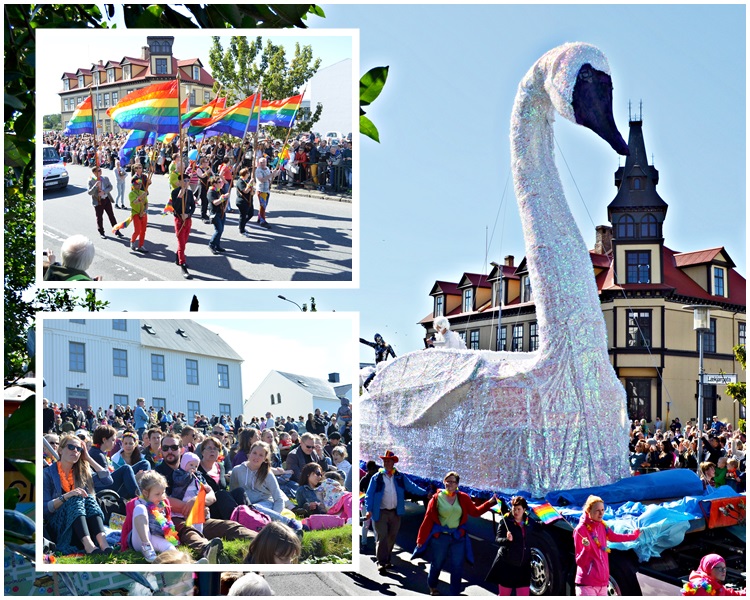
Main photo: Eva María and girlfriend Birna Hrönn Björnsdóttir at Reykjavík Pride.

